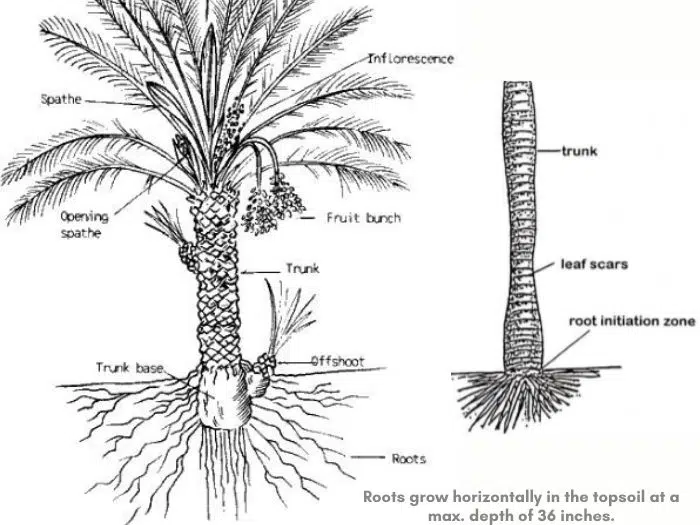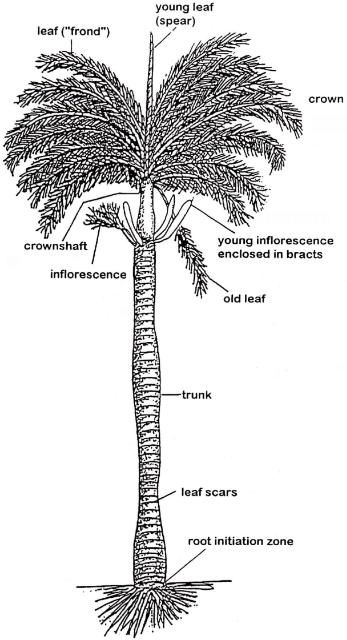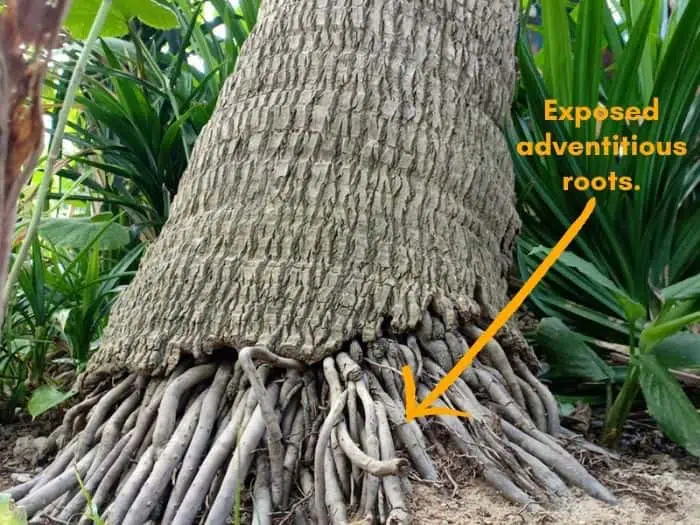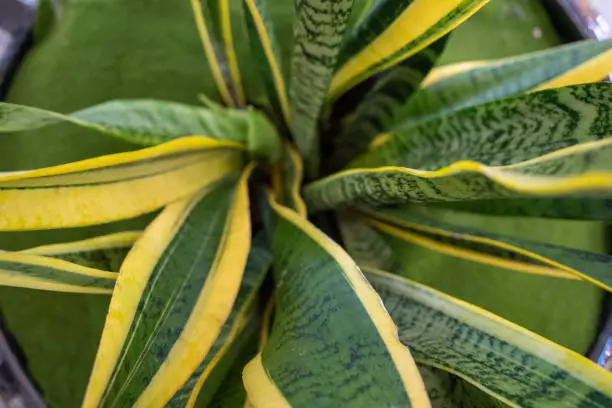Palm trees make great yard trees that you can plant along your fences to beautify your home. Some species, such as areca palm, can be grown indoors with proper root management. But how deep do palm tree roots grow?
Palm trees have a fibrous root system with the roots growing shallowly at a depth not exceeding 36 inches deep. They grow horizontally and remain narrow even as the plant grows taller. Roots form a root ball from the origination zone, with some remaining exposed above the ground.
Palm tree root system (diagram)
The root system of palm trees is quite different from many tall trees. Palms do not develop a taproot; roots emerge from the root initiation zone and spread horizontally around the tree within the top 36 inches of topsoil.

Palm trees have a fibrous root system where multiple narrow roots extend out and spread in the soil instead of growing downward. These roots remain thin even as they grow longer.
Some roots start to die off and more roots regenerate to help the plant feed and anchor itself strongly in the ground.
The length of the roots does not increase to match the tree’s height. You can find a tree over 50 feet tall with roots way shorter than that. The fibrous root system is adapted to maximize nutrient and water absorption by branching out extensively.
How deep are palm tree roots?
Palm tree roots grow horizontally within the top 36 inches of the soil. They remain narrow and maintain a shallow depth even as they elongate.
But how far do the roots of a queen palm tree grow? Even though the tree can grow large, its roots spread out widely at a depth of no more than 24 inches. If you’re planting a queen palm in your yard, water at a wider diameter to ensure all the horizontal roots have access to water and nutrients.
How do palm tree roots grow?
Palm trees can grow an additional 3-10 inches each year if conditions are favorable. The roots, however, may not grow so deep as you’d expect a tree that can reach heights of over 100 feet to grow.

Credit: A. W. Meerow, UF/IFAS
Palm tree roots grow in the top 36 inches of topsoil where it is easy to access nutrients and water. The tree forms a root ball from which thin strands of roots grow at the base and spread horizontally to tap the most nutrients. Some roots may be exposed and visible above ground.
Here are a few interesting facts on how the roots of a palm tree grow:
- Root system: Fibrous
- Growth pattern: Horizontal
- Depth: 36 feet (shallow)
- Exposed roots? : Yes (adventitious roots)
Roots grow horizontally
Instead of growing straight down, palm tree roots like to grow horizontally and spread within the topsoil region limited to 12-36 inches deep. They can spread far away from the trunk of the palm tree as an adaptation to absorb as much water and nutrients as possible.
Most types of palm trees grow in moist but loose and well-draining soil (sometimes sandy soil) where water retention is low. The roots spread horizontally from the trunk and root ball to increase the surface area for water and nutrient absorption. This helps the tree grow faster and thrive even in hot seasons.
If you want to plant large palm tree cultivars, you might want to space them adequately, about 11 to 12 feet apart and away from ground drainage pipes to prevent damage.
Proper spacing also allows the trees to spread their roots adequately, reduces competition for water and nutrients, and sturdy anchoring for support against strong winds.
The root ball
The roots of a palm tree do not grow as big as the tree itself. They maintain the same girth even as they grow long. As the roots spread horizontally away from the trunk, they form a root ball that helps hold the tall tree firmly in the soil.
For example, a short palm tree about 16 ft can have a root ball with a diameter of approximately 24 inches.
Palm trees develop a rootball even when they’re young which helps them to anchor firmly in the ground. The ball of roots manifests in potted palm trees that, when transplanted, form the origin of the horizontally spreading roots.
Pro tip: Use the size of the root ball as a guide for the size of the hole to dig up when transplanting your palm tree. Dig up a hole twice the size of the root ball to ensure enough room to put the plant in and create enough loose soil around it to allow new roots to grow easily.
To reduce the risk of your palm tree toppling over in a storm or strong winds, ensure the top of the root-shoot interface is about one inch below the surface.
In indoor trees such as areca palms, the root ball can become tight and compacted. This can lead to brown leaves and generally poor health and growth rates.
Roots exposed above ground
The area at the base of the trunk in palm trees contains actively growing cells and can grow roots that are exposed above the ground. These roots are called adventitious roots and can appear to be dry. Exposed roots are inactive but the plant will continue to feed through roots underground.

Above-ground roots are normal in palm trees especially if they develop their own. They emerge from the root initiation zone but since they are exposed to a dry environment, they desiccate and stop growing.
Pro tip: When transplanting your palm tree, dig the hole deep enough such that the root zone is at least 2-3 inches beneath the soil surface.
Do palm tree roots destroy pipes?
The roots of palm trees can not damage pipes because they are narrow and long, growing horizontally and fairly shallow. However, large cultivars of palm trees can cause disturbance to plumbing pipes in the ground if planted in the yard.
Queen palms, for example, are big and can grow large root balls that can push against underground plumbing pipes and cause some damage.
If you have drainage pipes under your yard, you might want to plant a variety of palm trees that do not grow too big. That way, you’ll be sure the tree’s roots won’t damage your pipes.
Can palm trees damage cement?
Palm trees will unlikely damage concrete and cement surfaces because the roots maintain the same diameter as they grow longer. The thin roots are not going to cause cracks and lines in driveway cement and even in walls.
Other types of roots such as oak can cause damage because their roots grow thicker as the tree ages.
If you’re growing palms in your yard, space them properly as they can draw nutrients over a large diameter and cause poor ground cover growth.
Removing palm tree roots
If the roots of your palm trees are invasive and pose a risk to nearby structures, removal may be necessary. Uproot the stump and the root carefully so as not to damage other systems such as building foundations, drainage trenches, and sprinkler systems in your yard.
To remove a palm tree root, dig around the trunk with a shovel to remove about 20-25 inches of soil surrounding the tree. This will give you access to the roots, so cut them off with an ax and then dig up any big roots that may remain.
Since the roots of the palm tree can grow back, apply a herbicide that’s strong enough to kill off the palm tree and prevent it from growing again. Simply apply Roundup or any glyphosate alternative herbicide that’s strong enough to kill the palm tree and its roots.
Here’s a video on how to remove the roots of a palm tree:
Do palm tree roots grow back?
Not all varieties of palm trees can grow back after the trunk is cut. Those that grow back are clustering palms known to sprout new stems from roots once the trunk is cut off.
For most of the other varieties of palm trees, cutting the trunk will mean the tree will die, so make sure you’re cutting down your palm trees for wood or other uses because they will not grow back.
Unlike the trunks, the roots of the trees usually regenerate, which is why you can cut a certain amount of roots from the tree when transplanting and still be able to revive the plant.
It is even possible to prune off roots that grow beyond the root ball and the plant will still survive and revive as new roots rejuvenate. However, this practice may weaken the tree and make it more susceptible to storm damage.



